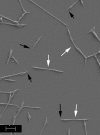Potential Molecular Targets for Narrow-Spectrum Agents to Combat Mycoplasma pneumoniae Infection and Disease
- PMID: 26941728
- PMCID: PMC4766277
- DOI: 10.3389/fmicb.2016.00205
Potential Molecular Targets for Narrow-Spectrum Agents to Combat Mycoplasma pneumoniae Infection and Disease
Abstract
As Mycoplasma pneumoniae macrolide resistance grows and spreads worldwide, it is becoming more important to develop new drugs to prevent infection or limit disease. Because other mycoplasma species have acquired resistance to other classes of antibiotics, it is reasonable to presume that M. pneumoniae can do the same, so switching to commonly used antibiotics like fluoroquinolones will not result in forms of therapy with long-term utility. Moreover, broad-spectrum antibiotics can have serious consequences for the patient, as these drugs may have severe impacts on the natural microbiota of the individual, compromising the health of the patient either short-term or long-term. Therefore, developing narrow-spectrum antibiotics that effectively target only M. pneumoniae and no more than a small portion of the microbiota is likely to yield impactful, positive results that can be used perhaps indefinitely to combat M. pneumoniae. Development of these agents requires a deep understanding of the basic biology of M. pneumoniae, in many areas deeper than what is currently known. In this review, we discuss potential targets for new, narrow-spectrum agents and both the positive and negative aspects of selecting these targets, which include toxic molecules, metabolic pathways, and attachment and motility. By gathering this information together, we anticipate that it will be easier for researchers to evaluate topics of priority for study of M. pneumoniae.
Keywords: adherence; antibiotics; metabolism; mycoplasma; toxins.
Figures
Similar articles
-
Impact of viral coinfection and macrolide-resistant mycoplasma infection in children with refractory Mycoplasma pneumoniae pneumonia.BMC Infect Dis. 2020 Aug 26;20(1):633. doi: 10.1186/s12879-020-05356-1. BMC Infect Dis. 2020. PMID: 32847534 Free PMC article.
-
Overview of antimicrobial options for Mycoplasma pneumoniae pneumonia: focus on macrolide resistance.Clin Respir J. 2017 Jul;11(4):419-429. doi: 10.1111/crj.12379. Epub 2015 Oct 13. Clin Respir J. 2017. PMID: 26365811 Review.
-
Antimicrobial therapy of macrolide-resistant Mycoplasma pneumoniae pneumonia in children.Expert Rev Anti Infect Ther. 2018 Jan;16(1):23-34. doi: 10.1080/14787210.2018.1414599. Epub 2017 Dec 11. Expert Rev Anti Infect Ther. 2018. PMID: 29212389 Review.
-
Mycoplasma pneumoniae: Current Knowledge on Macrolide Resistance and Treatment.Front Microbiol. 2016 Jun 22;7:974. doi: 10.3389/fmicb.2016.00974. eCollection 2016. Front Microbiol. 2016. PMID: 27446015 Free PMC article. Review.
-
Mycoplasma pneumoniae Carriage With De Novo Macrolide-Resistance and Breakthrough Pneumonia.Pediatrics. 2019 Oct;144(4):e20191642. doi: 10.1542/peds.2019-1642. Epub 2019 Sep 5. Pediatrics. 2019. PMID: 31488697
Cited by
-
Mycoplasma pneumoniae from the Respiratory Tract and Beyond.Clin Microbiol Rev. 2017 Jul;30(3):747-809. doi: 10.1128/CMR.00114-16. Clin Microbiol Rev. 2017. PMID: 28539503 Free PMC article. Review.
-
Dual dye-loaded Au@Ag coupled to a lateral flow immunoassay for the accurate and sensitive detection of Mycoplasma pneumoniae infection.RSC Adv. 2018 Jun 11;8(38):21243-21251. doi: 10.1039/c8ra03323d. eCollection 2018 Jun 8. RSC Adv. 2018. PMID: 35539903 Free PMC article.
-
Research status and challenges of Mycoplasma pneumoniae pneumonia in children: A bibliometric and visualization analysis from 2011 to 2023.Medicine (Baltimore). 2024 Mar 15;103(11):e37521. doi: 10.1097/MD.0000000000037521. Medicine (Baltimore). 2024. PMID: 38489686 Free PMC article.
-
Evaluating the Genetic Capacity of Mycoplasmas for Coenzyme A Biosynthesis in a Search for New Anti-mycoplasma Targets.Front Microbiol. 2021 Dec 20;12:791756. doi: 10.3389/fmicb.2021.791756. eCollection 2021. Front Microbiol. 2021. PMID: 34987490 Free PMC article.
References
-
- Baseman J. B., Morrison-Plummer J., Drouillard D., Puleo-Scheppke B., Tryon V. V., Holt S. C. (1987). Identification of a 32-kilodalton protein of Mycoplasma pneumoniae associated with hemadsorption. Isr. J. Med. Sci. 23 474–479. - PubMed
Publication types
LinkOut - more resources
Full Text Sources
Other Literature Sources
Research Materials


